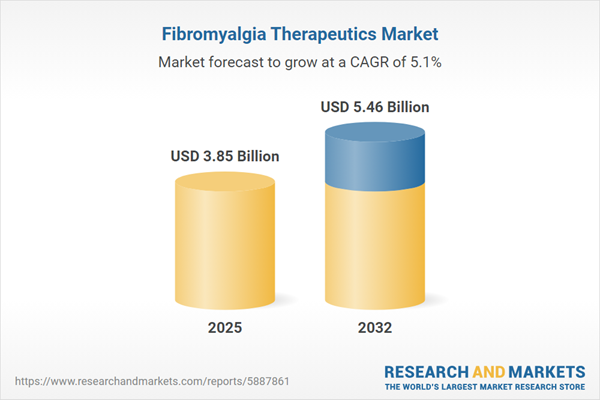Speak directly to the analyst to clarify any post sales queries you may have.
Senior decision-makers navigating the fibromyalgia therapeutics market face a sector shaped by dynamic regulation, evolving care models, and rapid technological change. Targeted market intelligence is essential to inform adaptive strategies and maintain resilience against shifting market pressures.
Market Snapshot: Fibromyalgia Therapeutics Market
The fibromyalgia therapeutics market continues to grow at a steady pace, driven by ongoing pharmaceutical innovation and advanced care approaches that emphasize measurable improvements for patients. Digital health platforms are now central, streamlining patient-provider interactions, supporting proactive engagement, and enabling real-time monitoring of health status. These advancements enhance integration within clinical pathways and help organizations respond flexibly to both payer requirements and the progression of value-based healthcare. Additionally, digital therapies expand access and adaptive care delivery—especially relevant for chronic disease management and the expansion of remote or collaborative care models.
Scope & Segmentation in the Fibromyalgia Therapeutics Market
- Drug Class: Both branded and generic anticonvulsants, as well as a diverse range of antidepressants, contribute to therapy individualization, ensuring clinicians align treatment options to changing patient profiles and emerging clinical results.
- Route of Administration: Oral, parenteral, and topical delivery formats offer flexibility, helping providers tailor symptom management approaches while supporting adherence and overall patient satisfaction.
- Distribution Channel: Hospital pharmacies, retail options, and expanding online pharmacy networks broaden access to medications for chronic pain, strengthening distribution reliability and improving supply efficiencies.
- End User: Stakeholders, including home care providers, specialty clinics, and large hospital systems, ensure consistency in therapy and support complex patient needs through collaborative approaches to care delivery.
- Regional Coverage: North America, Latin America, Europe, Middle East & Africa, and Asia-Pacific comprise markets with unique operational and regulatory characteristics, demanding localized strategies and adaptation to varying adoption rates.
- Company Coverage: Market leadership stems from key players such as Pfizer Inc., Eli Lilly and Company, AbbVie Inc., Teva Pharmaceutical Industries Ltd., Viatris Inc., Sandoz International GmbH, Sun Pharmaceutical Industries Ltd., Torrent Pharmaceuticals Ltd., Dr. Reddy's Laboratories Ltd., and Cipla Limited, all actively advancing partnerships and product innovation.
Key Takeaways: Strategic Insights for Executive Leadership
- Anticonvulsant therapies establish a critical foundation for clinical protocols, supporting ongoing refinement of practice guidelines.
- Progress in biomarker discovery is enabling more targeted therapy selection, reducing inefficiencies and improving overall predictability in patient outcomes.
- Adoption of digital health tools enhances patient engagement, allowing for adaptive, individualized care pathways that better suit fibromyalgia management strategies.
- Growth in specialty and online pharmacy participation strengthens therapy accessibility, helping ensure long-term continuity for chronic pain patients across regional markets.
- Integrated home-based care models, complemented by specialty clinics, contribute to improved operational efficiency and consistent support across varied patient scenarios.
Tariff Impact: U.S. Policy and Global Supply Chains
Recent U.S. regulatory changes have increased sourcing costs for pharmaceutical ingredients critical to fibromyalgia therapeutics. Organizations are reacting by diversifying manufacturing locations, leveraging free trade zones, and refining production strategies to protect the stability of therapy delivery and supply chains regardless of shifting global market dynamics.
Methodology & Data Sources
Insights in this report stem from interviews with neurologists, rheumatologists, pain specialists, and health economists, along with surveys involving pharmacists and healthcare administrators. Data from clinical trials, regulatory reviews, and published research underpin the analysis, providing granular and actionable recommendations.
Why This Report Matters for the Fibromyalgia Therapeutics Market
- Equips senior leaders to refine therapeutic portfolios, identify potential partnerships, and proactively plan for changing market conditions.
- Supports improved resource and distribution planning, promoting alignment with payer and provider needs across diverse regions and dynamic care environments.
- Clarifies the strategic value of digital transformation, enabling executive teams to prioritize technology adoption for sustained organizational growth.
Conclusion
Adapting to regulatory and supply chain changes positions executive teams to manage ongoing challenges in the fibromyalgia therapeutics sector, turning transformation into new avenues for competitive advantage.
Additional Product Information:
- Purchase of this report includes 1 year online access with quarterly updates.
- This report can be updated on request. Please contact our Customer Experience team using the Ask a Question widget on our website.
Table of Contents
3. Executive Summary
4. Market Overview
7. Cumulative Impact of Artificial Intelligence 2025
Companies Mentioned
The companies profiled in this Fibromyalgia Therapeutics market report include:- Pfizer Inc.
- Eli Lilly and Company
- AbbVie Inc.
- Teva Pharmaceutical Industries Ltd.
- Viatris Inc.
- Sandoz International GmbH
- Sun Pharmaceutical Industries Ltd.
- Torrent Pharmaceuticals Ltd.
- Dr. Reddy's Laboratories Ltd.
- Cipla Limited
Table Information
| Report Attribute | Details |
|---|---|
| No. of Pages | 194 |
| Published | October 2025 |
| Forecast Period | 2025 - 2032 |
| Estimated Market Value ( USD | $ 3.85 Billion |
| Forecasted Market Value ( USD | $ 5.46 Billion |
| Compound Annual Growth Rate | 5.0% |
| Regions Covered | Global |
| No. of Companies Mentioned | 11 |









